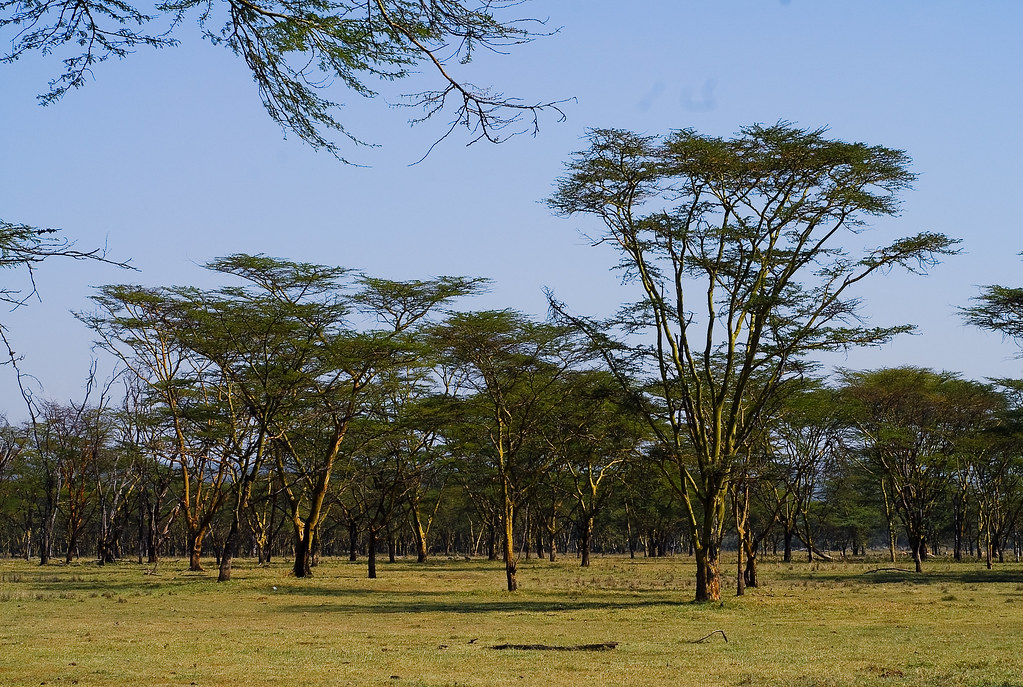Lake Nakuru National Park, located in Kenya’s Great Rift Valley, is not only famous for its birdlife and wildlife but also for its diverse plant species. The park’s vegetation ranges from open grasslands to wooded areas, providing critical habitats for the region’s fauna and contributing to the park’s overall ecosystem balance. Understanding the flora of Lake Nakuru is essential for appreciating the biodiversity that thrives in this protected area.
1. Dominant Vegetation Types
The park is home to a variety of ecosystems, with several key vegetation types that define its landscape:
- Acacia Woodlands: Acacia trees, particularly Acacia xanthophloea (fever tree), dominate many areas of Lake Nakuru. These trees thrive in the alkaline soils surrounding the lake and provide shade and shelter for both animals and birds.
- Euphorbia Forest: Lake Nakuru is known for its towering Euphorbia candelabrum (candelabra tree) forests. These unique trees can reach up to 20 meters and are well adapted to the semi-arid conditions. The Euphorbia forests are not only visually striking but also serve as habitats for various birds and small mammals.
- Grasslands: The open grasslands, particularly in the southern areas of the park, support large herbivores like buffaloes, rhinos, and zebras. These areas are characterized by drought-resistant grass species such as Themeda triandra (red oat grass) and Cynodon dactylon (Bermuda grass), which are well adapted to the variable rainfall and grazing pressure.
2. Riparian Vegetation
The rivers and freshwater streams that feed into Lake Nakuru, such as the Njoro River, are lined with riparian vegetation. This includes lush, green belts of trees and shrubs, providing crucial habitats for birds, small mammals, and insects. Key species in these areas include:
- Ficus sycomorus (sycamore fig)
- Tamarix spp.
- Phragmites reeds
These plants help stabilize the soil and filter water as it enters the lake, playing a vital role in maintaining the park’s hydrology.
3. Soda Lake Vegetation
Due to the highly alkaline nature of the lake, the immediate surroundings support unique salt-tolerant plant species. The lake’s shoreline is characterized by low-growing halophytic plants (salt-loving species) such as:
- Suaeda monoica: A saltbush that grows in the saline soils near the lake.
- Salicornia spp.: Another halophyte that thrives in areas where salinity is high.
These plants play a role in preventing soil erosion along the lake’s shores and provide habitat for invertebrates, which in turn support the bird populations.
4. Invasive Species
In recent years, invasive plant species have become a concern in Lake Nakuru National Park, threatening native vegetation and altering the ecosystem. Some of the notable invasive species include:
- Lantana camara: A shrub that spreads aggressively, outcompeting native plants and reducing biodiversity.
- Opuntia spp. (prickly pear cactus): This succulent species can take over large areas, affecting grazing lands for herbivores.
Conservation efforts are in place to manage these invasive species through mechanical removal and controlled burning.
5. Flora and Wildlife Interdependence
The plant life in Lake Nakuru plays an essential role in the survival of the park’s wildlife. For example:
- Acacia trees provide food for giraffes, whose long tongues and necks allow them to browse the thorny branches.
- Euphorbia trees are a nesting site for many birds, including the African fish eagle and cormorants.
- The grasslands sustain large herds of herbivores, including zebras, buffaloes, and antelopes.
6. Seasonal Changes in Vegetation
The park’s vegetation changes dramatically with the seasons. During the rainy season (March-May and October-December), the grasslands flourish, and the trees are in full leaf. In contrast, the dry season (June-September and January-February) brings a browning of the grasslands and leaf shedding in some tree species. These seasonal changes affect the behavior of the park’s wildlife, with herbivores migrating in search of fresh grazing and water sources.
7. Conservation and Restoration Efforts
Lake Nakuru National Park is facing environmental challenges such as deforestation in the Mau Forest (a key water catchment), pollution, and climate change, all of which impact the park’s vegetation. Restoration projects are underway, focusing on:
- Reforestation: Efforts to replant indigenous trees, particularly around deforested areas and riverbanks.
- Wetland restoration: Protecting the lake’s wetlands, which are critical for water filtration and support diverse plant and animal life.
- Management of invasive species: Ongoing programs aim to control the spread of invasive plants through eco-friendly methods.
8. Endemic and Notable Plant Species
Some plant species found in Lake Nakuru National Park are unique to the Rift Valley region. These include:
- Aloe kedongensis, a succulent that grows in the dry rocky areas.
- Fever tree (Acacia xanthophloea), whose yellow-green bark gives it a distinctive appearance, contributing to the park’s visual landscape.
In summary, the diverse plant life at Lake Nakuru National Park is integral to its ecosystem, supporting a wide range of wildlife and contributing to the park’s ecological balance. Conservation efforts, sustainable tourism practices, and awareness about the park’s flora are essential for ensuring that this unique landscape continues to thrive.

